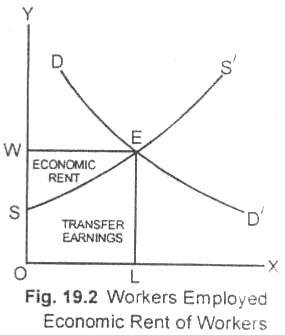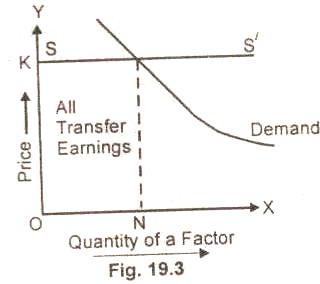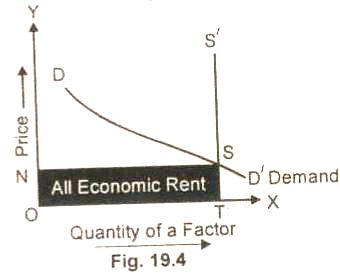The modern economists like Pareto, Mrs. Joan Robinson, Boulding, Sligler,
Shepherd, have tried to simplify and generalize the
ricardian theory of rent.
According to them, the Ricardian theory of rent is too closely related to land.
This creates on impression that rent is a peculiar earning of land only. The
fact, however, is that other factors of production i.e., labor, capital and
entrepreneurship may also be earning economic rent. The determination of rent,
the modem economists say, can be explained in the same manner as the reward of
other factors, that is by demand and supply forces.
Demand and Supply Analysis:
(A) Demand For a
Factor:
The demand for a factor which may be land,
labor or
capital is a derived demand. Land, say for instance, is demanded for its
produce. The higher the produce, the greater is the demand for land. A firm
will pay rent equal to the marginal revenue productively of land. The rent
diminishes as more land is used due to the operation of
law of diminishing
returns. The demand curve of a factor is, therefore, negatively sloped which
means more land will be used only at lower rents, other things of course
remaining the same.
Supply of a factor.
The supply of land to a particular use (say industry) is quite elastic. It
can be shifted to other uses by offering higher rent than that being earned by
it now. The supply of a factor (to an industry) is, therefore, rent elastic. If
higher rent is paid, the supply of a factor can be increased by withdrawing it
from other uses. The supply curve of a factor (industry) slopes upward to the
right.
Diagram:

Determination of rent.
The economic rent is determined by the intersection of demand and supply
curves for a factor. In this figure (19.2), the demand curve for a factor say
labor in a particular industry is DD/ and the supply curve of workers is SS/.
The wage rate or factor price of labor as determined by the market forces is
OW. The total workers employed in a particular industry at OW wage rate is OL.
The total earning of the workers employed is equal to the area OWEL. At wage rate
OW, there are workers who would work, at lower pay but they are also paid at
OW
wage rate. Those workers whose transfer earnings are less than this wage
rate will be getting economic rent. The total economic rent earned by all the intra marginal workers is equal in
the area WES. The marginal worker i.e., Lth worker is not obtaining any rent or
surplus.
(B) Rent is a Surplus
Return:
The modern economists are also of the view that
rent as a surplus can be earned by other factors also. It is not peculiar to
land alone as explained by Ricardo. The modern theory of rent is that it is the
difference between the actual earning of a factor unit over its transfer
earnings. The transfer earnings of a factor of production is the minimum payment
required for preventing that factor for transferring it to some other use. It is
called the factor supply price in its present occupation.
For example, a worker
earns $6000 per month in a factory. In the next best employment, he can get $5000 only per month. The surplus or excess of
$1000 which a worker is
earning over and above the minimum payment necessary for inducting him to work
in the present occupation is the economic rent.
Economic Rent Depends on the
Elasticity of Supply of the Factor of Production:
The proportion of the income of a factor that consists of economic
rent depends on the elasticity of supply of the factor of production which may
be (i) totally inelastic supply (ii) perfectly elastic supply and (iii) less than
perfectly elastic supply.
(i) Perfectly elastic supply.
When the supply of a factor of production is perfectly elastic, then none of its
income is economic rent. Its entire income is transfer earnings.

In the Fig. 19.3, the supply curve SS/ is a horizontal line. Whatever the
amount of factor demanded, the supply price remains at OS. Hence, it
earns no surplus in the nature of rent.
(ii) Totally inelastic supply. When the supply of a factor is
totally inelastic, then its transfer earnings is zero. The entire income is
economic rent.

In the fig. 19.4, the elasticity of the supply of factor of
production is zero. It does not increase at all as its demand increases. The
supply curve is vertical. The entire of factor income is a surplus which is shown by
area ONST.
(iii) Less than perfectly elastic supply. If the supply of a factor of production is neither perfectly elastic nor perfectly inelastic as
illustrated